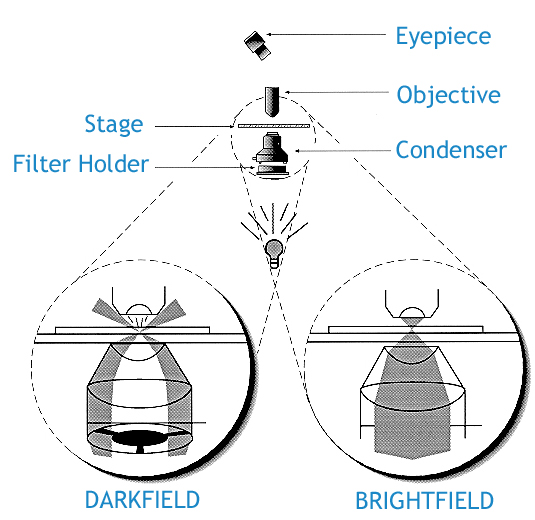Brightfield microscopy uses light from the lamp source under the microscope stage to illuminate the specimen. This light is gathered in the condenser, then shaped into a cone where the apex is focused on the plane of the specimen. In order to view a specimen under a brightfield microscope, the light rays that pass through it must be changed enough in order to interfere with each other (or contrast) and therefore, build an image. At times, a specimen will have a refractive index very similar to the surrounding medium between the microscope stage and the objective lens. When this happens, the image can not be seen. In order to visualize these biological materials well, they must have a contrast caused by the proper refractive indices, or be artificially stained. Since staining can kill specimens, there are times when darkfield microscopy is used instead.
In darkfield microscopy the condenser is designed to form a hollow cone of light (see illustration below), as opposed to brightfield microscopy that illuminates the sample with a full cone of light. In darkfield microscopy, the objective lens sits in the dark hollow of this cone and light travels around the objective lens, but does not enter the cone shaped area. The entire field of view appears dark when there is no sample on the microscope stage. However, when a sample is placed on the stage it appears bright against a dark background. It is similar to back-lighting an object that may be the same color as the background it sits against - in order to make it stand out.
Darkfield Microscope Applications
- Viewing blood cells (biological darkfield microscope, combined with phase contrast)
- Viewing bacteria (biological darkfield microscope, often combined with phase contrast)
- Viewing different types of algae (biological darkfield microscope)
- Viewing hairline metal fractures (metallurgical darkfield microscope)
- Viewing diamonds and other precious stones (gemological microscope or stereo darkfield microscope)
- Viewing shrimp or other invertebrates (stereo darkfield microscope)
Darkfield Microscope Options
- Metallurigcal reflected light brightfield/darkfield microscope.
- Metallurgical reflected and transmitted light brightfield/darkfield microscope.
- Stereo Zoom S6 Brightfield/Darkfield microscope.
- Digital Stereo Zoom FZ6 Brightfield/Darkfield microscope.
- Biological laboratory microscope BA210 with darkfield slider.
Already have a microscope, but your microscope manufacturer does not make a darkfield stop? If there is a filter holder below your condenser, we may carry at darkfield stop that will work. Or you can mount a coin or circle of another opaque material in the center of a clear disk and put it in the filter holder.





